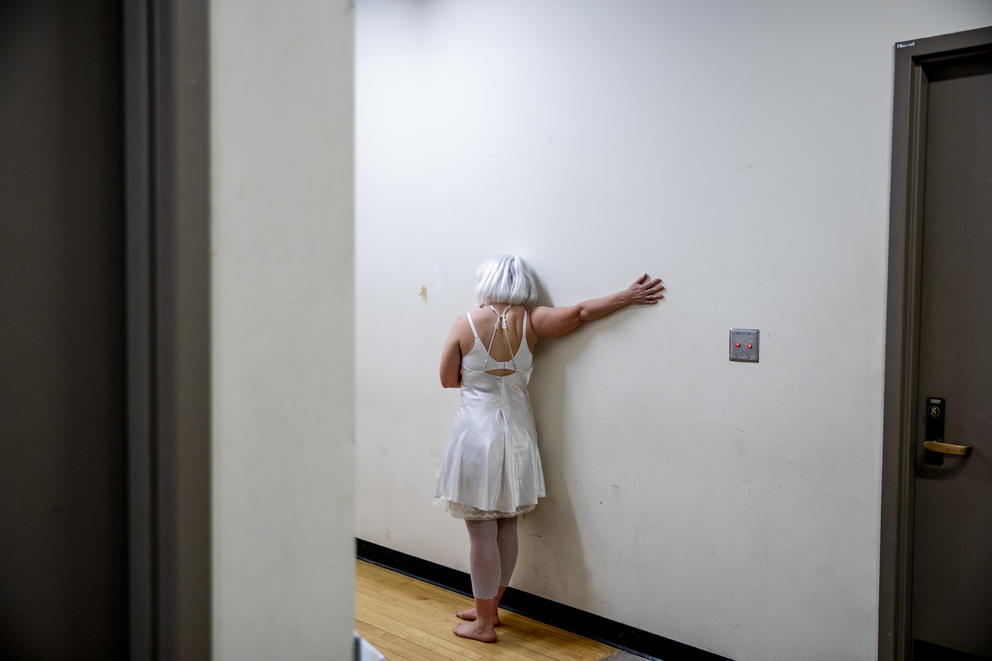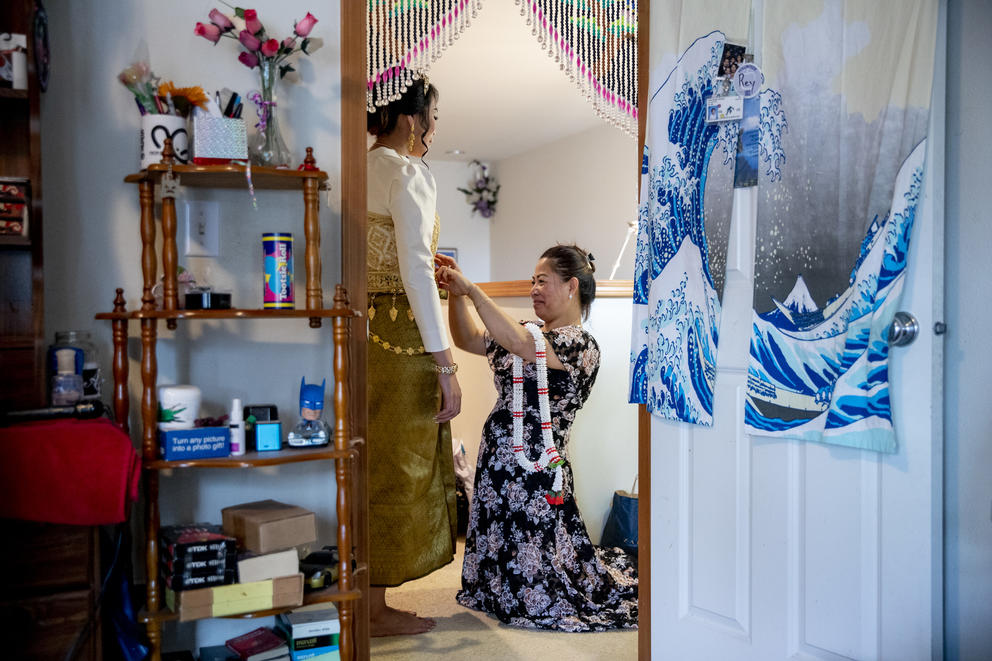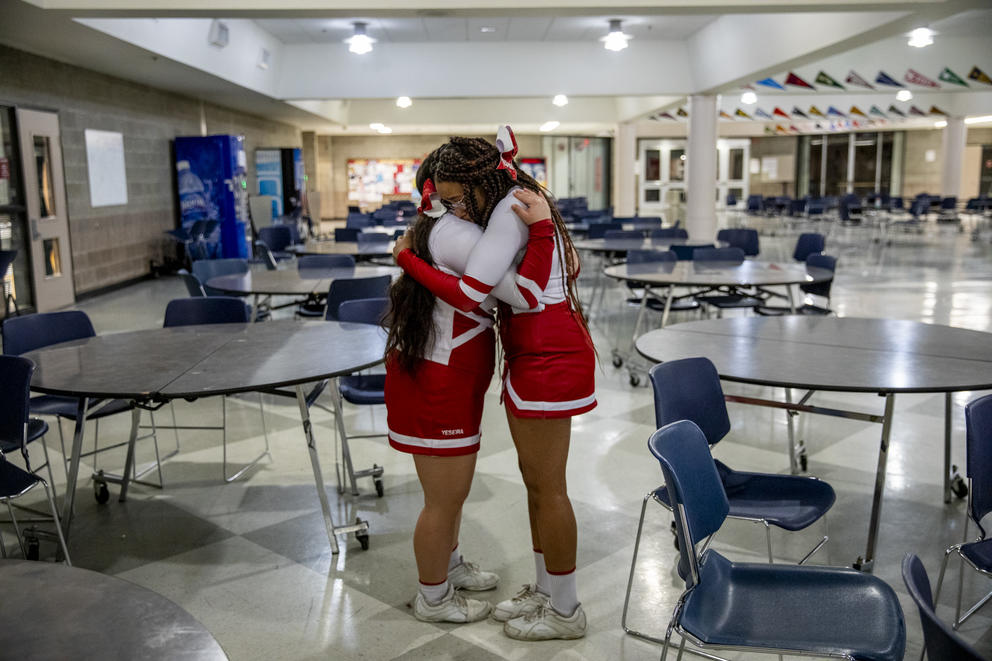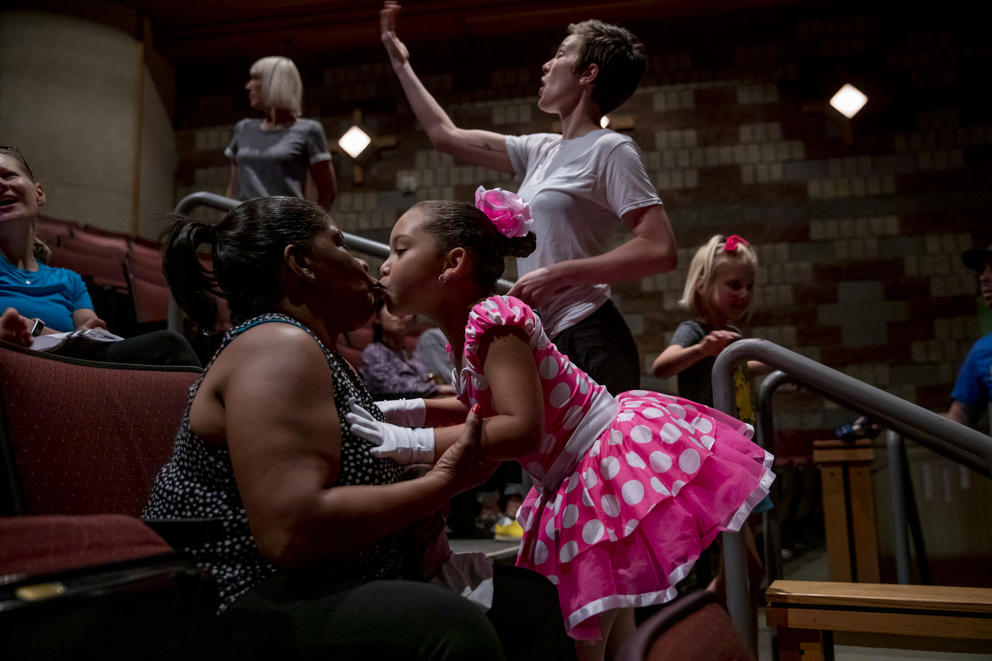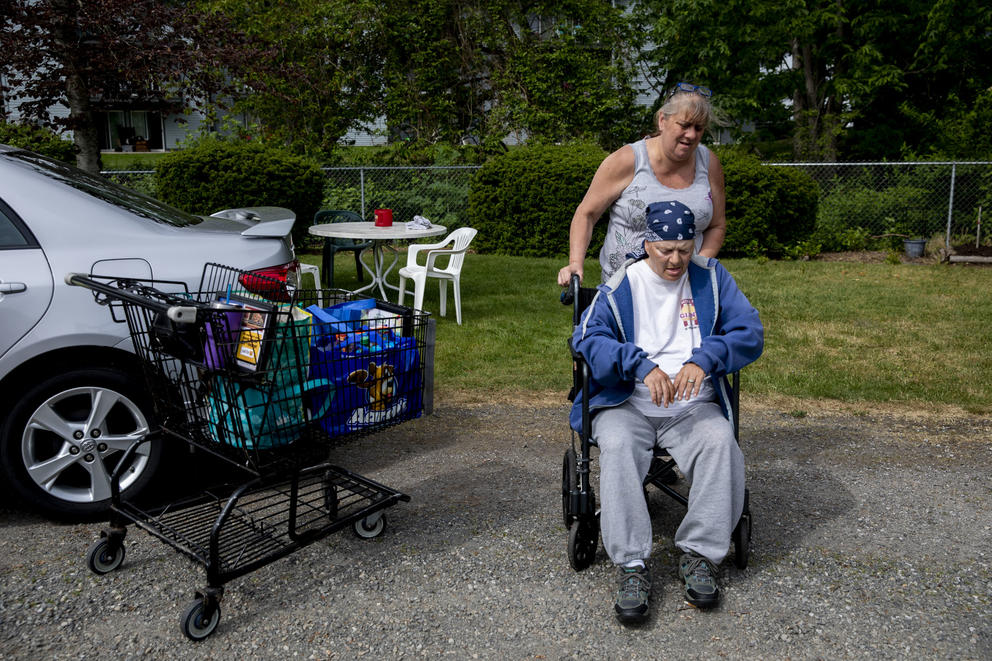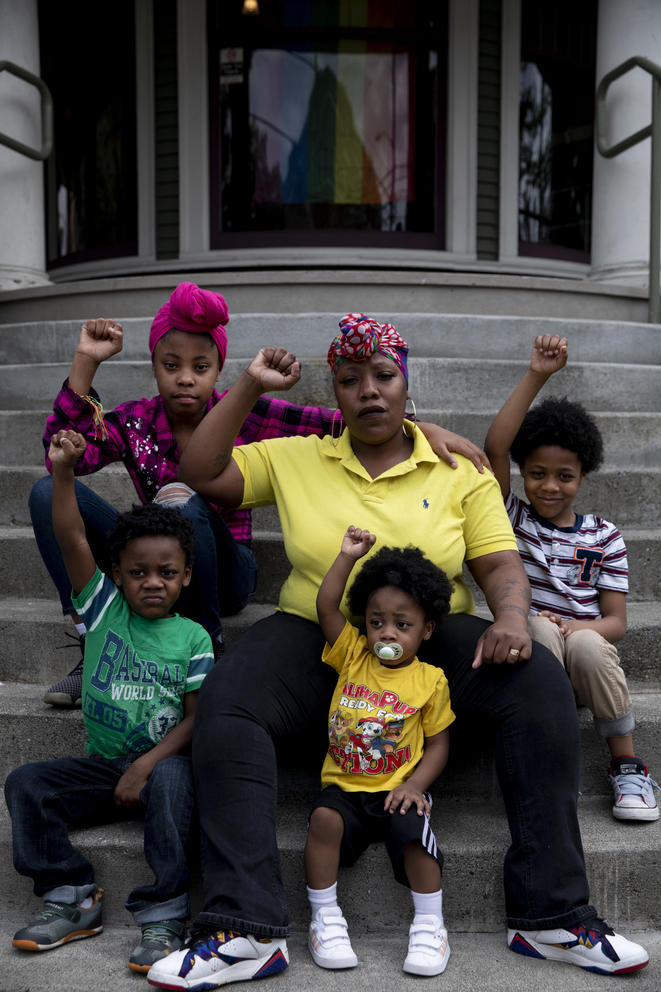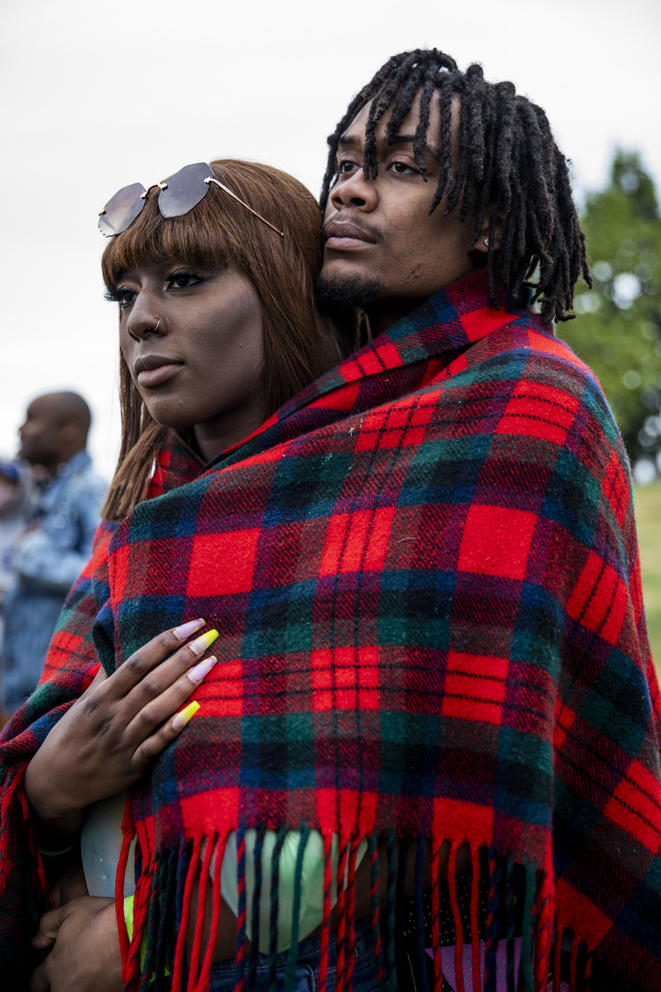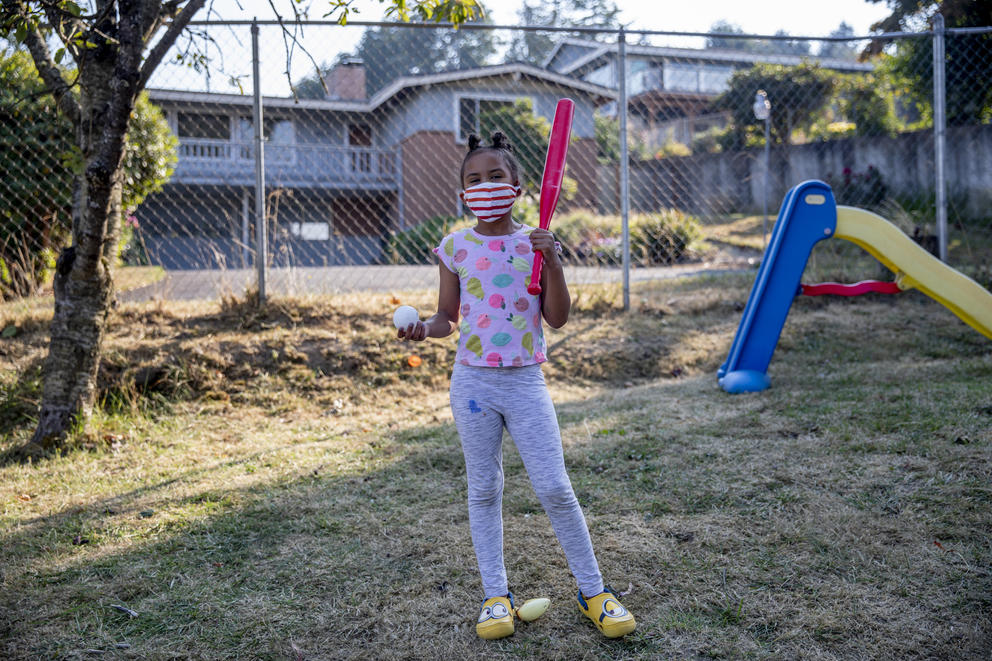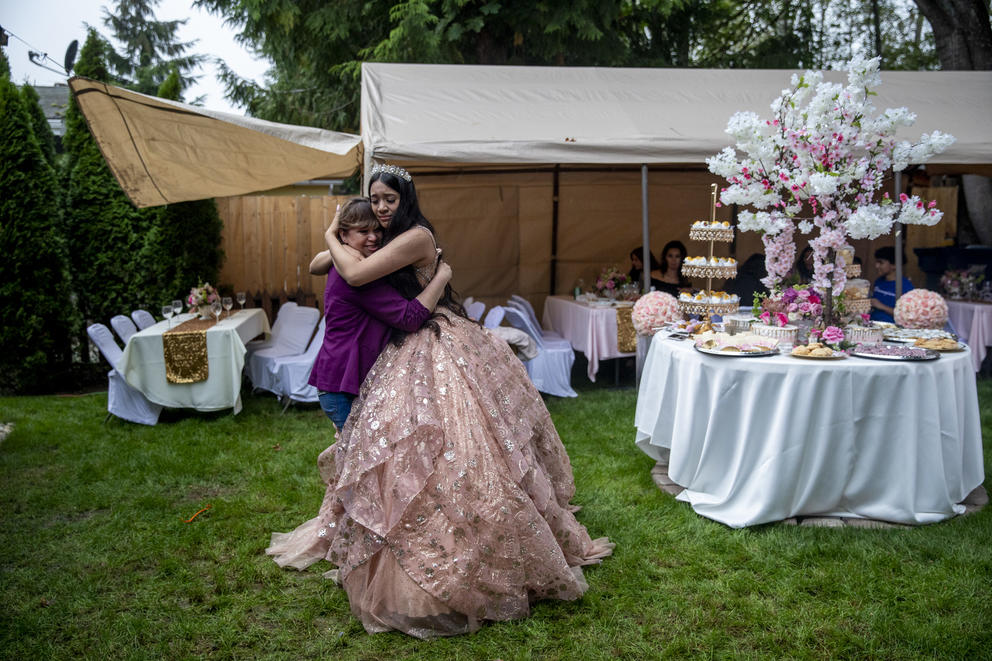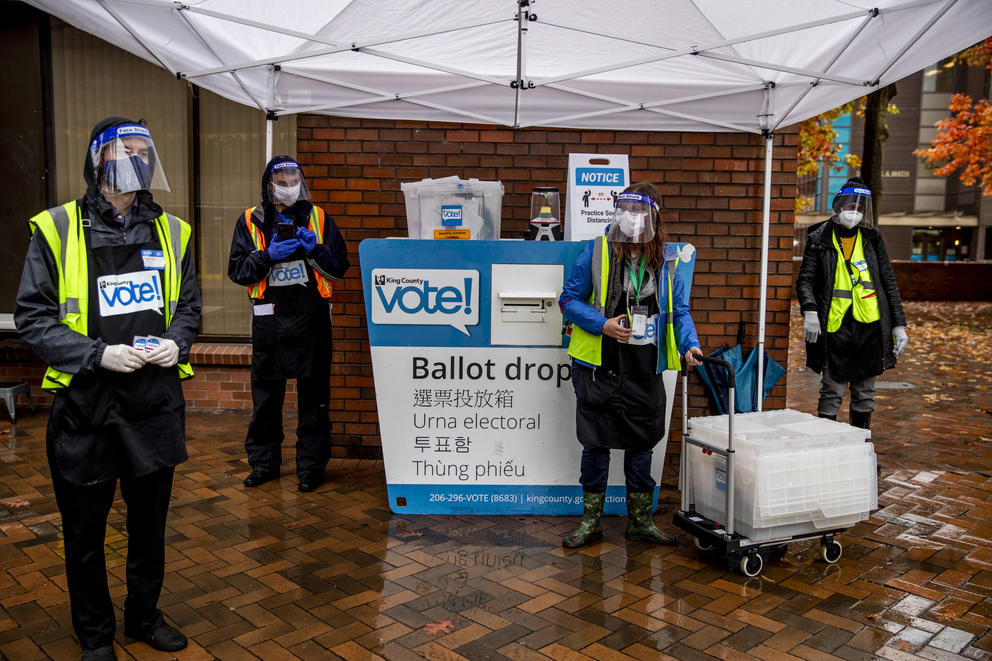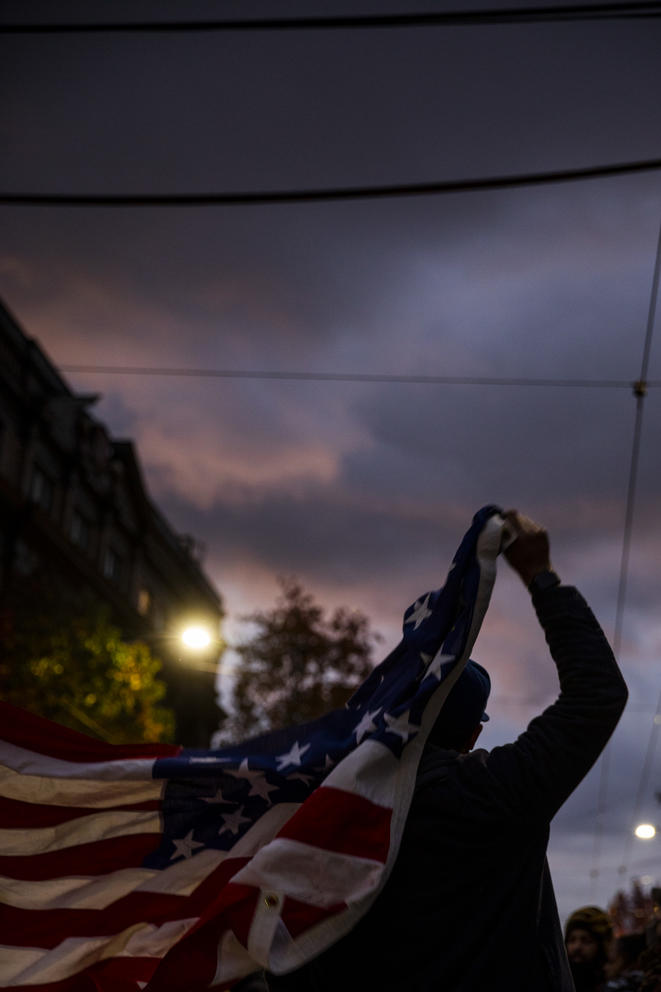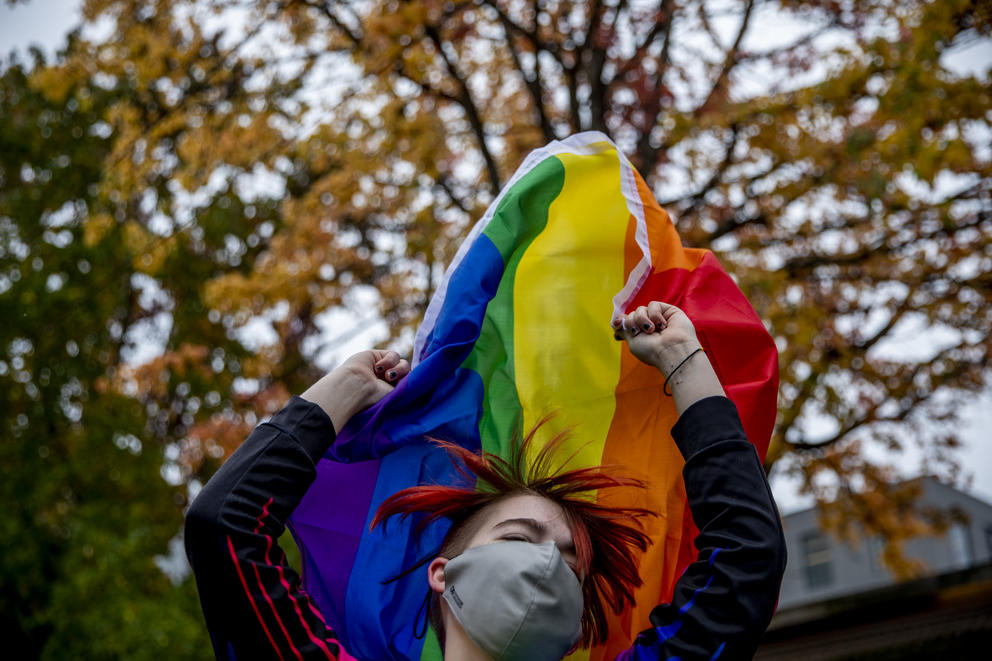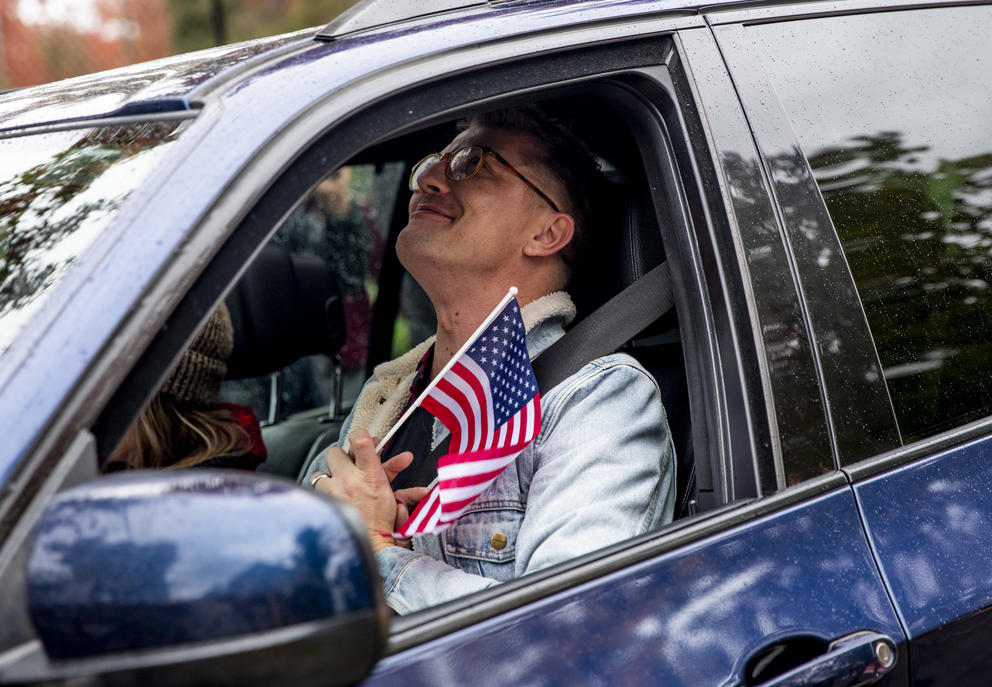Producer Diana Cardiff stretches backstage during dress rehearsal for “Buttcracker” at Erickson Theater. Cardiff has worked on the “Buttrock Suites” and “Buttcracker” since it started 2003. This was the final year of the show, which had become a treasured holiday tradition. Documenting the final weeks of this show, I learned about the real impact it had on people who went to see it — it was opening new doors for people. “I think it has helped break down some barriers people might have had [regarding] coming to see a dance performance,” Cardiff said. “I know for a fact that there’s a whole chunk of friends of mine who hadn’t really seen me perform in other things, and then I did “Buttrock Suites” [the “Buttcracker” predecessor] or “Buttcracker,” and that got them over their fear of modern dance and theater and those expectations. Some of them now have subscriptions to On the Boards, or go see other things, because they are like ‘Oh it’s not scary, I can go see dance stuff and it’s fine.’” — Dorothy Edwards
I met Nary in 2019 and began documenting her story. In this photo, she makes the final adjustments to Bory Khun's bride gown, before the start of a wedding in Kent. Along with running her own business during the day and working as a janitor at night, Kuy styles local Cambodian weddings. For her it is about preserving her culture and keeping her treasured Cambodian traditions alive, even far away from her home. Kuy’s story, about community, identity, and tradition, felt universal. — Dorothy Edwards
Back in January, I photographed Christine German in her home at the affordable housing complex 30Bellevue for a follow-up on the impact of Microsoft's half-billion-dollar loan to create thousands of affordable housing units in suburban King County. German shared the one-bedroom apartment with her puppy, Carmela, and her 15-year-old granddaughter. The family was homeless and staying with a friend from church before moving into the complex when it opened in May 2019. When I look back at this moment now, it feels bittersweet. At the time, it was an appealing, hopeful reminder of what positive change could look like in the community. After the pandemic strained social safety nets and forced many homeless folks out of shelters, and with the deadline on the eviction moratorium looming, I think about how one year down the line, the need for affordable housing is greater than ever. — Jen Dev
Tribal elder Pauline Flett is helped into the Spokane Tribal Language and Culture building by Elizabeth Johnstone in Wellpinit, Washington. Jan 30, 2020. Flett was one of three members of her tribe who were completely fluent in the Spokane Salish dialect and worked for decades to document translations and teach others how to speak and read the language. “I sit down, and that’s it,” she said at the time. “If I think of something, I have to write it down before I forget — I might use it later if I’m not using it now.” After nearly 50 years of filling notebooks, Flett died of natural causes in a hospital on April 13, relatives said. Family members said she continued to make translations to her last day, determined not to let her knowledge and the language end with her. — Shaminder Dulai (Photo: Rajah Bose for Crosscut)
Donna Chipley stands on the front porch of her home, which has been elevated on cinderblocks to prevent flood damage, Jan. 28, 2020, in Hamilton in Skagit County. We had discovered Hamilton, 300-person town on the Skagit River, had befallen consistent flooding for years and might just be the most flooded town in Washington. A Seattle nonprofit invested in a $1 million effort to provide residents with a route to higher ground. But some residents insisted, ‘We're not relocating.’ — Shaminder Dulai (Genna Martin for Crosscut)
Earlier in the year, I followed a high school cheerleading team in Vancouver, Washington, on their road to the state championship for the first time in 16 years, making history for Fort Vancouver High School. One of the seniors, Jay Jay James, right, lost her boyfriend to a shooting a day before senior night, when this photo was taken, and a week before state. Witnessing the resilience and strength of James and so many of her teammates — the kind of strength teenagers should never have to muster — was incredibly inspiring, and I hope just as inspiring to people reading this team’s story. “Everybody struggled on the team,” James says, “and knowing people were going through stuff and still showing up to cheer, I knew I couldn’t give up. It has always been more than a team.” — Dorothy Edwards
I followed Alesia Cannady and her granddaughter, Aleiyah, 5, along with Alesia’s organization, Women United, for several months. Alesia started her organization to support other women and grandparents who are raising their grandchildren as she was. This community of grandmothers, or kinship caregivers, rely on each other for support where the state lacks. The state does provide some assistance to these caregivers, but it is relatively little compared with benefits for foster parents. I hope Alesia and the other grandmothers’ stories bring a little more light to the kind of support they need. — Dorothy Edwards
Emergency room technician Melissa Beaver, left, and nurse Jennifer Jordan pose for a photograph in a trauma room at MultiCare Deaconess North Emergency Center in Spokane, Feb. 11, 2020. The nurses from Spokane had noticed that many people they treated for strangulation were not receiving follow-up care or counseling for possible abuse they had experienced. Statistically, a person strangled by an abusive partner is 750 times more likely to be killed by that same person, and they were speaking up about what they viewed as overlooked domestic violence cases. In a year with global pandemic, it's easy to lose sight of other stories, but it is stories like these that remind me why we do this work — to research and look into underreported issues and give you the information you need to decide if it should continue as is. — Shaminder Dulai (Photo: Young Kwak for Crosscut)
Zach Landa-Cuevas, 12, touches the face of his mother, Carolina Landa, in his room at their home in Olympia, Feb. 5, 2020. Zach is on the autism spectrum, nonverbal and requires extra help from Landa and other caretakers on everyday tasks. When we met Carolina Landa, she was advocating for a bill that was under consideration in the state Legislature. The bill would allow her to volunteer at her son's school and vote, despite a past felony drug conviction. “Special needs parenting is a different kind of parenting,” Landa said. “It demands you to be thinking 24/7 of how you’re going to adjust the situation.” She said that discriminatory practices against those with criminal convictions add extra barriers to her own situation. — Shaminder Dulai (Photo: Genna Martin for Crosscut)
Gina Magee, 62, of Bellingham, arrives home with groceries with the help of her caregiver, Tammy. Magee was completely dependent on a caregiver to shop for groceries. Her story was part of a series looking at food insecurity in Western Washington. She used to be able to ride her motorized wheelchair to the Birchwood neighborhood Albertsons to shop for herself, but since the store closed three years ago, there was no longer a grocer close enough. "They took my independence," Magee said. Magee passed away before the story was published, but her legacy and the work she did, fighting for herself and her neighbors, lived on in her community as they continue to fight for a grocery store. — Dorothy Edwards
In early 2020, the Crosscut Visuals team collaborated with the Arts & Culture team to illustrate the relationship between artist and art. We settled on in-camera double exposures. We liked the idea of creating something in the moment, in collaboration with the artists, rather than creating a double exposure in a computer back at the office. For this image, Matt M. McKnight met with Daniel Acosta on March 6, 2020, while dancers prepared for an upcoming production at Velocity Dance Center, in Seattle's Capitol Hill neighborhood. This work, created in the first quarter of 2020, is a strange time capsule of a time before COVID-19 dominated every aspect of life. — Shaminder Dulai (Photo: Matt M. McKnight/Crosscut)
Adam Dotson, who lives in Seattle’s Rainier Beach neighborhood, visits his local Safeway store to pick up some groceries and beer on March 16, 2020. “I’m doing OK these days,” Dotson says. “My work hasn’t been affected by all of this yet, but I’m a little nervous and have to be extra careful not to bring coronavirus into my home if I were to get it.” As the pandemic took hold across Seattle and the rest of the United States in the weeks after Dotson's visit to the grocery store, he was laid off from his construction job. "I have been able to spend a ton of time at home getting things done and being way more present than was ever possible before," Dotson said on April 29. "In many ways, it has beat going to work ... but I should be getting back to my job any day now." — Matt M. McKnight
Tom and Marnie Malpass were self-quarantined in their home by COVID-19 on March 18, 2020 when we spoke over Facetime. Tom had just come back from the grocery store, the first time he left the house since entering self-quarantine. After weeks of being turned away from testing because of Centers for Disease Control and Prevention limits, Marnie tested positive on March 7 for COVID-19. The next day, Tom's test came back positive as well. The couple became cases number 1 and 2 in Kitsap County. In these early days of the state's stay-home order, much was still unknown about COVID-19. CDC guidelines instructed us to maintain social distance, but masks were not advised, and little was known about how long the virus could live on surfaces or how easily it could be passed. This also presented challenges for our team and required rethinking safety and approaches to stories. I spent my weekends and evenings researching COVID-19 and tapping my network of editors at other publications for advice and feedback on how to keep my staff and the people we meet healthy. Like many, we began photographing through windows and doorways and employed creative use of technology to minimize risk. —Shamider Dulai
A lone pedestrian crosses an empty downtown Seattle street amid the COVID-19 pandemic, March 18, 2020. During the pandemic’s early days in King County, many people went about their daily lives and commuting to work in the usual ways. The scenes of shuttered business and ghost town-like streets were only visions from other countries. Soon those scenes became a realization for most everyone in larger cities across the country. — Matt M. McKnight
In March, I was able to meet Dr. Deborah Fuller and a team from UW Medicine working on an mRNA COVID-19 vaccine. This team was developing vaccines long before the pandemic began. The researchers were working around the clock in a race to produce the vaccine. During this assignment, I learned the previous world record for developing a vaccine was four years. Creating a vaccine in a year was a remarkable feat. — Sarah Hoffman
This photo feels as if it was taken years ago; it's hard for me to believe it was just March. I was walking down the strip of restaurants by Alki Beach with my colleague, Lilly Fowler, who was writing about Seattleites ignoring social distancing recommendations as the virus spread. New measures had just recently closed down bars and restaurants in Washington state, with the exception of takeout and delivery services, and local officials were urging people to stay home or stay 6 feet apart. The public still hadn't grasped the severity of the situation. At Alki, storefront after storefront was closed, chairs upended on tables, but people still casually gathered in groups outside, playing Frisbee or holding bonfires on the beach. A few places, like Pepperdock Restaurant here, remained open to offer to-go fare, but social distancing was lax. A few days later, Gov. Jay Inslee issued a statewide stay-at-home order. The statewide mask mandate would come down months later, at the end of June. — Jen Dev
I wasn’t technically on assignment this weekend day in March, but I took my camera along on my hike to popular Rattlesnake Ledge near North Bend, sensing that the trails might be packed. The state had had its first coronavirus-related death only weeks earlier, on Feb. 29, and "social distancing" was still a new term. While local officials urged the public to stay inside or stay 6 feet apart when outside, as this image shows, it was wishful thinking. Even outdoors, people on the trail were often shoulder to shoulder, and a mask was a rare sight. Seattle Public Utilities, which owns and manages the Rattlesnake Lake Recreation Area, estimates that with nice weather, over 2,000 people visit the area each day, leaving little opportunity to physically distance. The very next day after my hike, Inslee announced statewide stay-at-home orders. Soon, this and hundreds of other trails were closed to the public. While the recreation area is now reopen for day use, the hiking trail remains closed until further notice. — Jen Dev
When the state's stay-home was issued, it was still unknown how long it was last. Just before April, we began to notice how empty the city had become, how clear the skies had become and how eerily quiet everything was. Photojournalist Matt M. McKnight and I spoke often about the quiet and recognized the historical weight of the moment. Around this time, national media had run headlines about Seattle becoming a ghost town. We didn't see it that way. For days, McKnight explored the streets and looked for humanity between the headlines. Here he came across a person, perhaps taking a moment of solace in downtown Seattle, March 30, 2020. — Shaminder Dulai (Photo: Matt M. McKnight)
Early in the pandemic, I witnessed how my own neighborhood of Ballard was changing. Businesses and restaurants shuttered and were boarded up. It was quiet and empty on sunny days where crowds would normally be shopping, getting ice cream or grabbing a drink with friends. I was inspired by the local artists who brought joy and a virtual art walk to the neighborhood with uplifting messages and a splash of color. Murals painted by artists on shuttered businesses line Ballard Avenue, April 12, 2020. — Sarah Hoffman
This photo was a bright spot for me in an otherwise punishing year. I met Sacha Davis, her wife, Megan, and their two home-schooled children in April, a few weeks after Seattle Public Schools had closed to slow the spread of the coronavirus. At the time, schools were tentatively scheduled to reopen on April 24. In the meantime, parents, students and teachers all suddenly found themselves at a loss for what to do and how to negotiate learning from home. Reporter Manola Secaira interviewed experienced home-schoolers like Davis, who runs a Facebook page for Seattle home-schoolers which saw an uptick in interest once the pandemic began. Nine months later, Seattle schools have not yet reopened, and while we have learned more about distance education, there is still much to be done. When I look back at this photo, I think about who can and cannot afford to home-school their children and the kids being left behind. — Jen Dev
In the spring, many people in Seattle began to work from home and social distance. It was a strange adjustment to keep physical distance from people and create connection without being able to share facial expressions. I remember feeling inspired and a little less alone by this little message in the sky. Hearts are illuminated in downtown Seattle, April 9, 2020. — Sarah Hoffman
Ramadan was one of the first major holidays impacted by COVID-19. The pandemic changed the way we gather, celebrate and support each other. In an effort to create community, the Muslim Association of Puget Sound streamed its services online, with hopes that by next Ramadan it would be safe to have large scale gatherings again. It was an eerie sight looking at a near empty room that should have been filled with people and celebration. Sulieman Abdulkeni, left, Mahjoub Mohamed, center, and Hassan Wado livestreamed an evening service for Ramadan on May 5, 2020 at the Muslim Association of Puget Sound in Redmond. The mosque was closed because of COVID-19 and would typically host celebrations for Ramadan with upwards of 1,000 people. — Sarah Hoffman
Richelle Madigan and her family have been through the wringer with their adopted son, Christian, seen in the photograph. He has had severe behavioral health issues since birth. Many parents would give up on such a kid. But the Madigans have fought hard for him to receive the best care possible — they currently drive eight hours just for a few hours of visitation at his psychiatric inpatient facility. Their love and attention were incredibly telling when I visited the family at their Moses Lake home, May 28, 2020. — Emily McCarty
After peaceful demonstrations turn to chaos on May 30, 2020, Interstate 5 was shut down and the governor called in the National Guard. Seattle was placed under a curfew, which was lifted days later as fears of violence subsided. (Matt M. McKnight/Crosscut)
Demonstrators raise their hands and stand in a cordoned-off intersection street downtown, May 30, 2020, as Seattle police officers regroup in the area. This year, we were reminded that progress against racism had not advanced as far as many believed. It was familiar territory for me. Six years earlier, I was the director of photography at Newsweek and had debated how to fight stereotypical images and combat tropes and assumptions. There was a feeling then that this national recockoning over race would give way to progress. Nearly half a decade later, we are still seeing debates over the same issues. — Shaminder Dulai
A passerby takes a picture of graffiti reading "I Can't Breathe," not far from a sign warning of COVID-19, May 30, 2020. This year, inequalities in society seemed to present themselves at every turn, from access to personal protective equipment and internet to food insecurity and an economic recovery that widened gaps between economic classes. This random moment, juxtaposing a pandemic that asks us to stay home against the societal ills of institutional inequality that asks us to rise up, seems apt for 2020. Making my way through downtown, listening to a police scanner and trying to remember to not touch my face, I'm reminded by this moment that life is a series of juxtapositions. — Shaminder Dulai
Men stand atop a utility box with fists raised to the sky while the peaceful ‘We Want to Live’ protest march makes its way through Rainier Valley, from Othello Park to Rainier Beach, June 7, 2020. — Matt M. McKnight
Quanshie Maxwell is a relative of Shaun Fuhr, who was killed by Seattle police on April 29, 2020. “His name was Shaun Fuhr. And he was shot by a sniper holding his 1-year-old daughter," Maxwell said, describing the incident when Fuhr was shot while holding his child. "They didn’t have compassion for his daughter and they didn’t have compassion for his life. Despite the situation, they didn’t give a f--. I’m not gonna stop. We want justice for him. We want justice for every other police brutality. When will enough be enough? When will I be able to feel like my kids are going to be ok when they leave me? I’m terrified for my sons. All three of my sons and my daughter. I’m an angry mom, a scared mom. It’s not gonna stop. So we are gonna march. We are gonna protest until we get justice.” — Dorothy Edwards
I met Miasia and Myles during ‘TAKING B(L)ACK PRIDE’ on June 27, 2020, a Pride event centering on Black trans and queer folks. Though Black trans activists have been at the center of the fight for LGBTQ rights since Stonewall, the annual Pride events in June have been criticized for being too white and too commercial. This day, specifically, the message was clear: Black trans and queer people were tired of waiting for Pride Month to start including them, so they created their own. — Dorothy Edwards
In June, the CHOP — the Capitol Hill Organized Protest area —became a gathering place for protests and conversations about racial injustice, police brutality and inequity. People walk through Cal Anderson Park, June 14, 2020. The area surrounding Cal Anderson Park had been claimed by protesters and included art installations, a co-op, a medical tent and a library. — Sarah Hoffman
In August, photojournalist David Ryder showed us a collection of images he had made of the summer's protests. For weeks, Seattle Police had used blast balls, rubber bullets and other non-lethal police projectiles used for crowd control in downtown. After looking at David's work and speaking with him about how to present it, I paired two images of blast ball grenades he had collected during protests on July 25, 2020. David had researched how blast balls work and found that they contain oleoresin capsicum, also known as OC or pepper spray, a chemical skin and respiratory irritant. The use of "tear gas" would become a point of debate with bans being imposed by the mayor several times. — Shaminder Dulai (Photo: David Ryder)
Alina Taylor, an undergraduate at Seattle University, travels from Phinney Ridge to West Seattle's High Point neighborhood and back, Aug. 20, 2020, for her summer work with Americorps, where she is assigned to Seattle Housing Authority and the city of Seattle's Children and Youth Summer Food Program. — Matt M. McKnight
The day Ruth Bader Ginsburg died, I found out about it before my partner. I had no idea how to tell them that one of their heroes had passed away. Months after I had mourned John Lewis, it was now time to mourn again. We didn't admire these people for their politics or opinion on governing; we admired them for their resolve to overcome obstacles and then follow it up by being one of the few that open doors for others on their way up. It was yet another hardship in an already hard year. On Sept. 19, 2020, I documented mourners as they placed candles at a vigil in honor of Justice Ginsburg at the U.S. District Court in downtown Seattle. — Shaminder Dulai
Evelyn Hernandez and her mother, Mariana, hold each other and cry during Evelyn’s quinceañera on Oct. 3, 2020. I photographed this day with the family as a part of a story looking at how milestones have been reshaped in 2020. Nearly 800 guests were originally going to be in attendance, but the family scaled it down to a small backyard celebration with just a handful of close family and friends. Growing up in Mexico with little money, Mariana didn’t have a quinceañera. She said it was important to her to give her daughter something she never had herself. On this day, Evelyn and a couple of friends took photos in front of the pink and floral decorations while her dad, Jorge, made carne asada on the grill. She took turns dancing with each member of her family — her mom, dad and little sister — and said she couldn’t help but feel emotional. Although Evelyn’s day was different from what she imagined, she said she didn’t feel disappointed. She felt thankful. “Both of my parents giving me everything I have and not having to worry about anything else. I just let that sink in,” she said, “like they're really here for me. They're always going to be here for me.” — Dorothy Edwards
Joel Linares Salgado was brutally attacked in March 2020. An expletive-filled video of the attack, a video that included racial epithets, was released on social media, prompting community activists to call on the state to prosecute the incident as a hate crime. According to the FBI, Washington state has one of the highest number of hate crimes in the country. In 2018, there were 506 in the state, with race and ethnicity being the most common motivating factor. Only New York, California and New Jersey had more. Photojournalists Jovelle Tamayo met with Salgado and his family on Nov. 1, 2020, at his home in Burlington in Skagit County. — Shaminder Dulai (Photo: Jovelle Tamayo for Crosscut)
The general election in November was unlike any other in so many ways. With election workers dressed in personal protective equipment, collecting ballots seemed like a striking visual reminder of the times we are living in. In this photo, King County election workers tend to the Capitol Hill ballot box on Nov. 3, 2020. — Dorothy Edwards
Election Day 2020 was historical and anxiety-inducing. We knew that the day itself wouldn’t bring any concrete answers regarding the presidential race, but that didn’t stop me from obsessively checking the news every five minutes. Leaving that night on assignment was almost a relief, but there was palpable tension in the air. The whole country seemed to be waiting with bated breath, and the threat of civil unrest loomed. My colleague Lilly Fowler and I went downtown to cover a Black Lives Matter demonstration moving from South Lake Union to Capitol Hill. Just as we arrived on scene, police began arresting demonstrators. It was a continuation of the protests and debate over police reform that had been taking place since the killing of George Floyd back in May. To me it was a reminder that no matter the outcome of the election, there was still plenty of work to be done. — Jen Dev
Hundreds of demonstrators march through downtown Seattle, Nov. 4, 2020, for a myriad of causes: racial justice, Black liberation, the protection of all people and for all votes in the 2020 election to be counted. The demonstration was organized in part by a coalition of groups including Seattle Evening March, Morning March Seattle, Black Action Coalition and the Engage Team. The protests also drew people who wanted to be around others dealing with post-election anxiety. — Shaminder Dulai (Photo: Jovelle Tamayo for Crosscut)
The early morning of Nov. 7, 2020 began like most days, with a barrage of push notifications to greet me in bed. I rubbed the crud from my eyes and tried to slide out without disturbing the cat. I read message after message confirming that after days of counting, Joe Biden was over the threshold of 270 electoral votes needed to become president-elect. It may have been Saturday, but it was time to go to work. As an editor, I don't make it out into the field often, but our staff photojournalists were on another assignment. So I grabbed my go bag and raced out the door to relive the "good ol’ days" when I was a staff photojournalist at newspapers and magazines. On Capitol Hill I met Brittney Moraski. She was waving at pedestrians, dancing and singing along to Kool & the Gang's "Celebration." "It's been a hard year," she said, as she rattled off a litany of concerns, including racial, income and health inequality, along with climate change and getting the pandemic under control. "We've got to build back better," she said. — Shaminder Dulai
While documenting the celebrations in the streets of Capitol Hill after Joe Biden was projected the winner of the presidential election, I saw Kyle dancing. Kyle, 14, told me he identifies as queer and finally felt hopeful for his future. “I’m just really excited because I feel safe and free and I’m not scared,” he said. “I was scared that I wouldn’t be able to grow up and be who I am and now I think that I can.” — Dorothy Edwards
Nearly a month since Joe Biden was declared president-elect, supporters of President Trump continue to protest the election’s result. Small pockets of protests and rallies to claim the election was rigged and stolen continue to pop up periodically around Washington state. On Dec. 6, 2020, dozens gathered to hold a “Stop the Steal” car parade, drawing both cheers and jeers from onlookers as they drove through the city, on Dec. 6. Beginning with prayer and the reciting of the pledge of allegiance, participants waved Trump and U.S. flags out their windows and shouted their support for a second Trump term. Trump lost the presidency by 74 electoral votes. Republican candidates, their teams and their supporters have not presented any credible proof of election fraud. On the contrary, voting officials from both political parties have stated publicly that the election was fair. — Shaminder Dulai (Photo: Rajah Bose for Crosscut)


